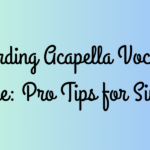Singing acapella is one of the most authentic ways to showcase your voice. Without instruments or backing tracks, your voice becomes the star of the performance. But when it comes to recording acapella vocals at home, many singers struggle with clarity, balance, and sound quality.
The good news? With the right setup and a few pro techniques, you can capture clean, powerful acapella recordings right from your bedroom or home studio. This guide will show you how.
Why Recording Acapella Matters
Recording your voice is more than just capturing a song—it’s about growth, practice, and performance. Here’s why acapella recording is valuable:
-
Improves Self-Awareness – Hearing yourself back highlights areas for improvement.
-
Tracks Your Progress – Compare recordings to see how your voice develops over time.
-
Prepares for Performances – Practice songs in a way that feels close to live singing.
-
Creates Content – Share performances on YouTube, TikTok, or Instagram.
When done properly, recording acapella at home helps you sound polished and professional without needing a studio.
Step 1: Choose the Right Space
The room you sing in affects your sound more than you might think. For the best results:
-
Pick a quiet room away from outside noise.
-
Use a smaller space with carpets, curtains, or soft furniture to absorb echo.
-
Avoid tiled rooms or kitchens where sound bounces.
If you don’t have access to an ideal room, hang blankets or use foam panels to dampen reflections.
Step 2: Essential Equipment
While you can record using just a smartphone, better gear makes a big difference. Consider:
-
Microphone – A USB condenser mic is great for beginners.
-
Pop Filter – Reduces harsh “p” and “b” sounds.
-
Headphones – Closed-back headphones prevent sound bleed.
-
Audio Interface – If using an XLR mic, this connects it to your computer.
-
Recording Software (DAW) – Free options like Audacity or GarageBand work well.
This doesn’t need to be expensive—budget-friendly gear can still produce great results.
Step 3: Recording Setup
Once your equipment is ready:
-
Position your mic about 6–8 inches away from your mouth.
-
Stay slightly off-center to avoid “pops.”
-
Record in a standing position to support your breath.
-
Use headphones to monitor your voice.
A simple but consistent setup ensures professional-sounding recordings every time.
Step 4: Techniques for Clean Acapella Recording
To get a polished sound:
-
Warm Up First – Always prepare your voice before recording.
-
Record Multiple Takes – Choose the best one later.
-
Stay on Pitch – Use a piano app or tuner as a reference.
-
Experiment with Layers – Try harmonies or vocal percussion to enrich your sound.
-
Edit Lightly – Use EQ to balance, reverb for space, and compression for clarity.
Practicing these steps will quickly improve the quality of your recordings.
Step 5: Using Technology to Enhance Your Sound
Modern apps and software make recording at home easy. For example, some recording acapella apps allow you to record multiple layers, mix your vocals, and share directly to social media. These tools are perfect for singers who want professional results without a complex studio setup.
Common Mistakes to Avoid
-
Recording in a noisy room – Background sounds ruin takes.
-
Over-editing – Too many effects can make vocals sound artificial.
-
Singing too close to the mic – Causes distortion and “pops.”
-
Skipping warm-ups – Leads to strain and poor tone.
Avoiding these mistakes helps you capture a clean and natural vocal performance.
Pro Tips for Better Results
-
Record at the same time each day to track vocal consistency.
-
Practice mic technique pull back slightly on louder notes.
-
Keep water nearby to stay hydrated.
-
Record short sections instead of full songs if you get tired.
-
Always save your raw, unedited takes you may want to revisit them later.
Conclusion
Recording acapella vocals at home doesn’t require an expensive studio setup. With the right environment, affordable gear, and careful technique, you can capture high-quality recordings that showcase your voice in its purest form.
Whether you’re preparing for performances, practicing harmonies, or creating content for social media, learning the art of recording acapella is an investment in your growth as a singer. Start simple, experiment, and let your voice shine.

